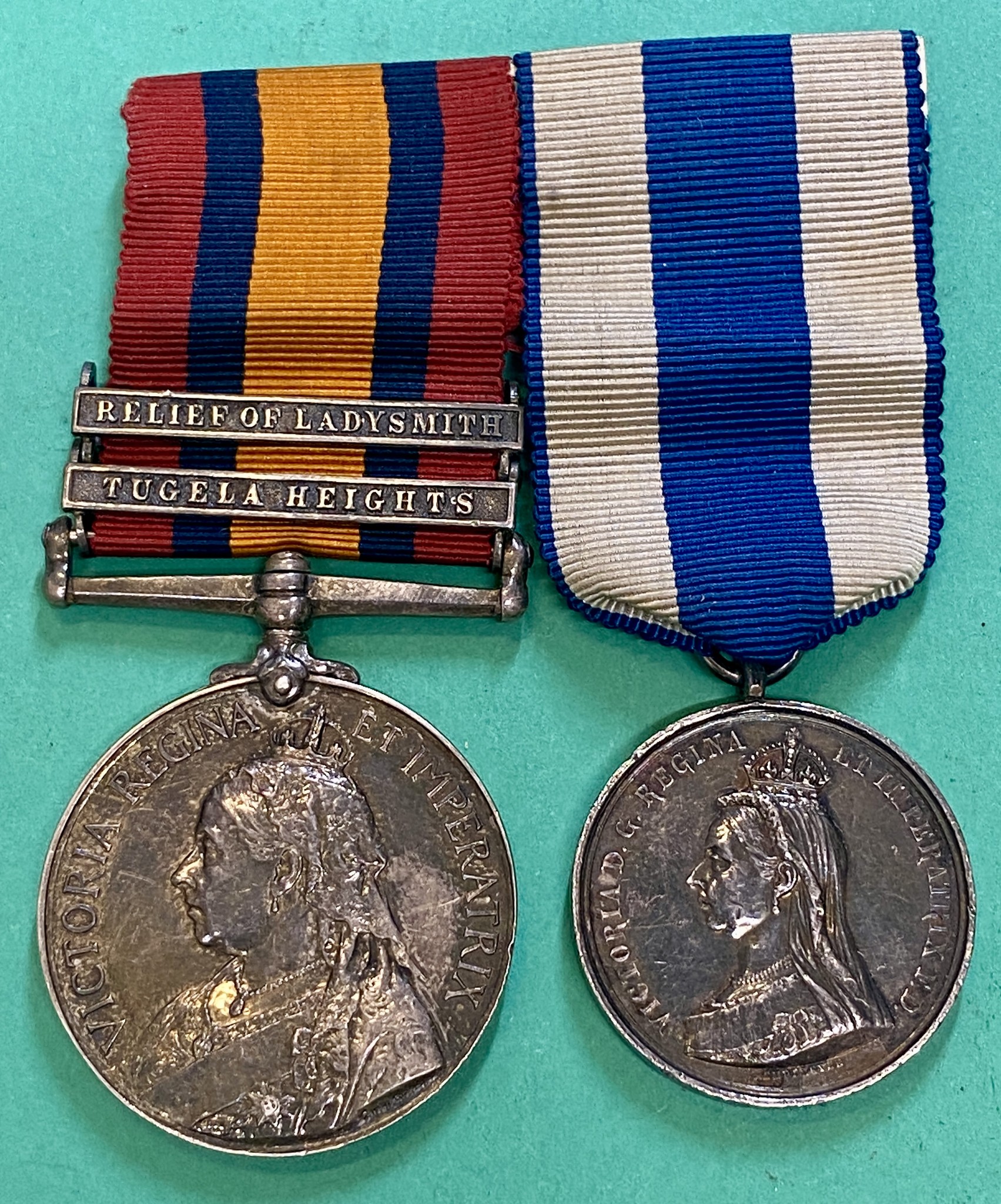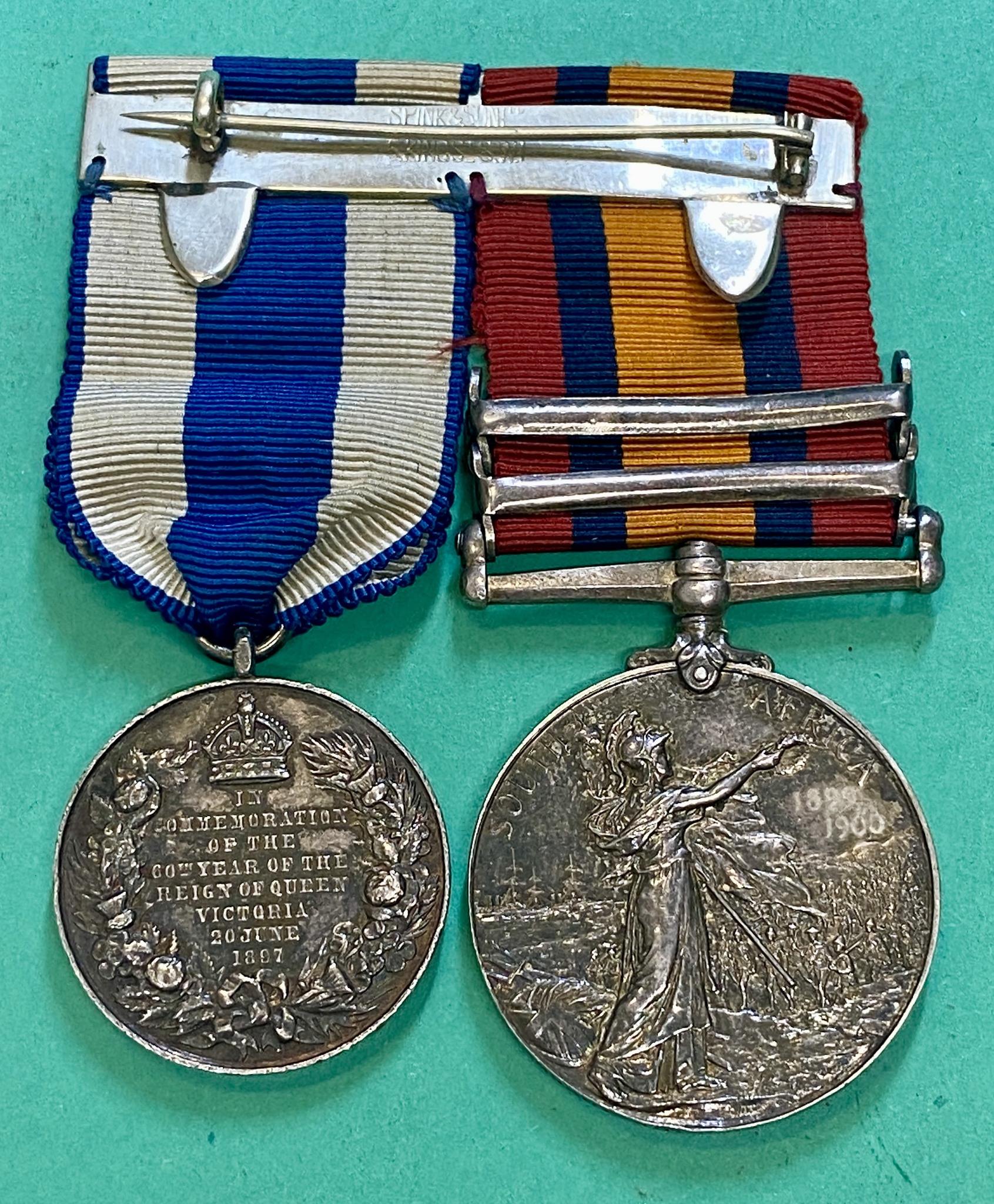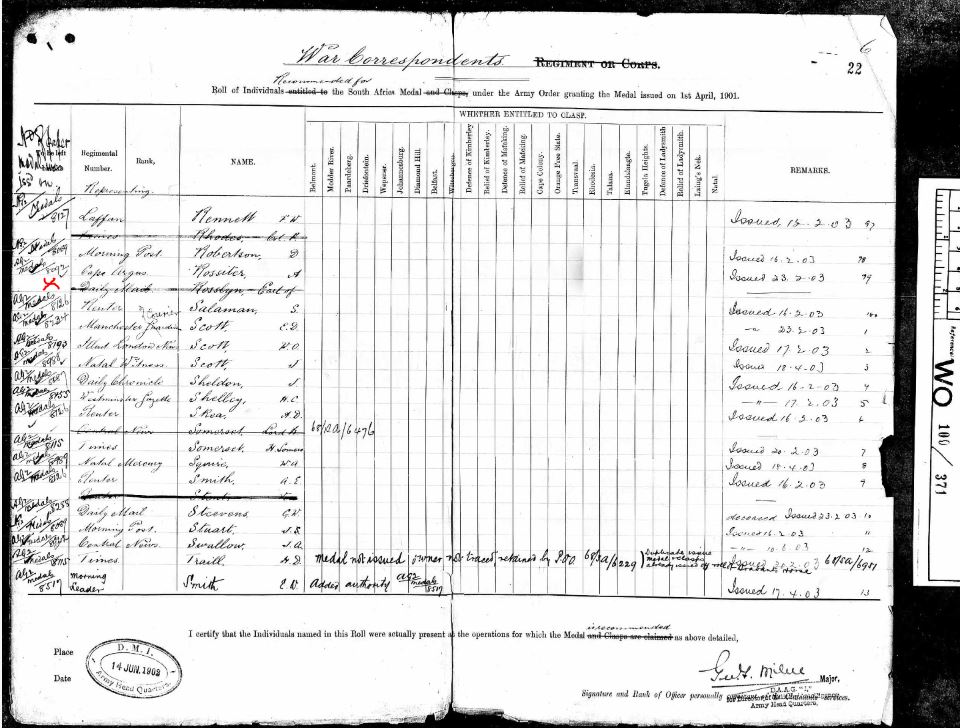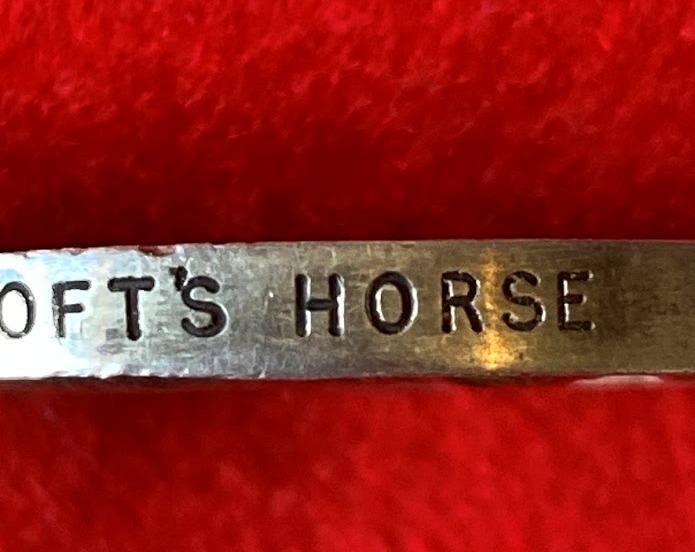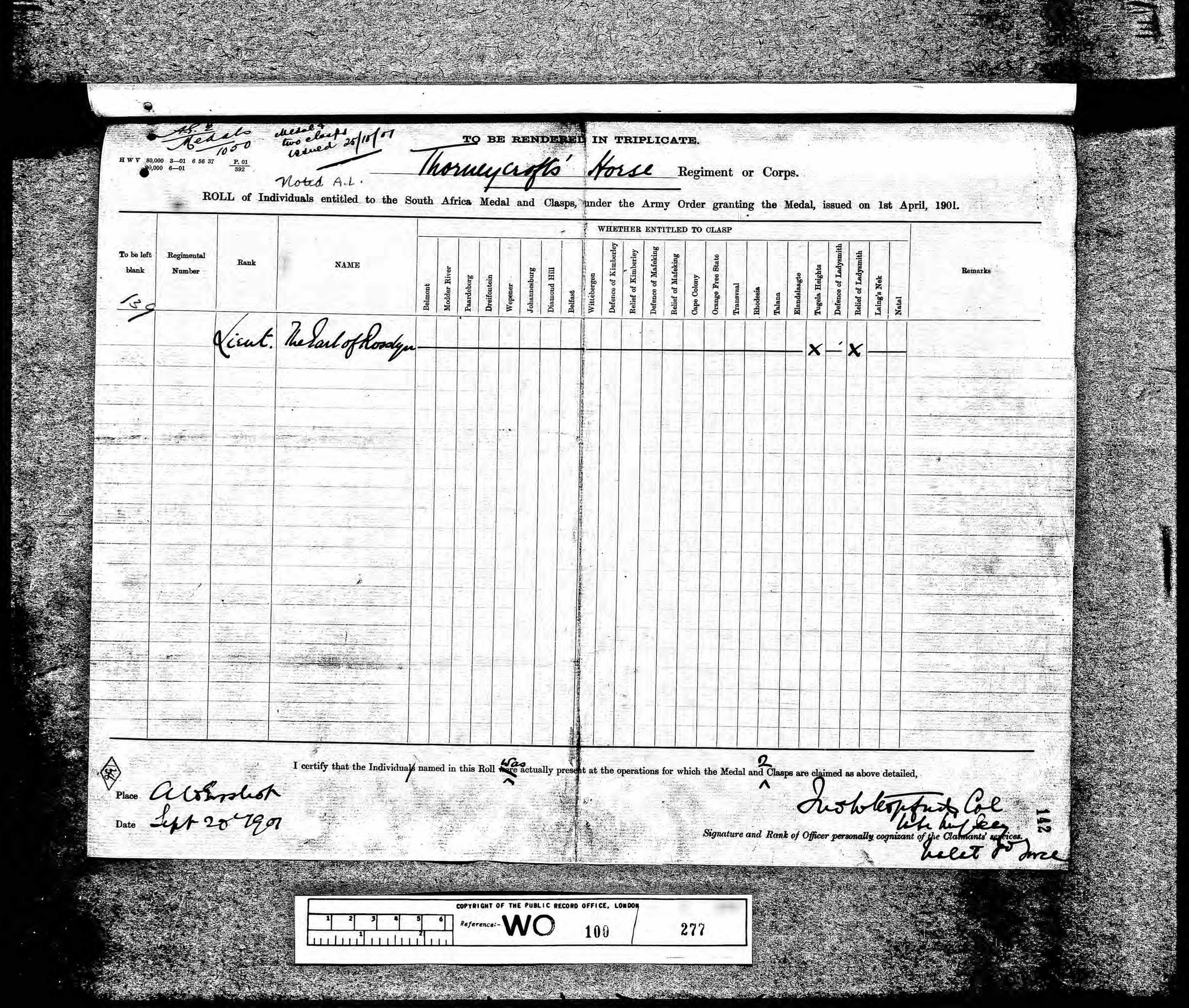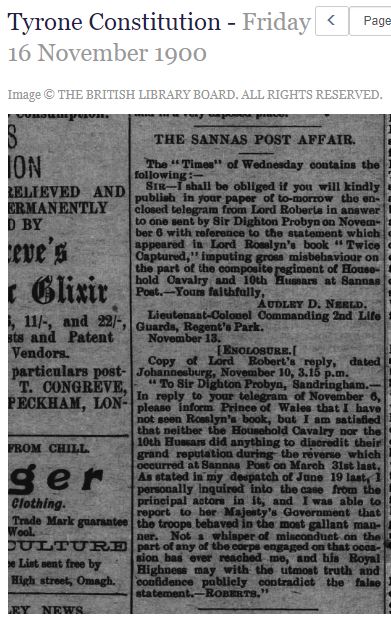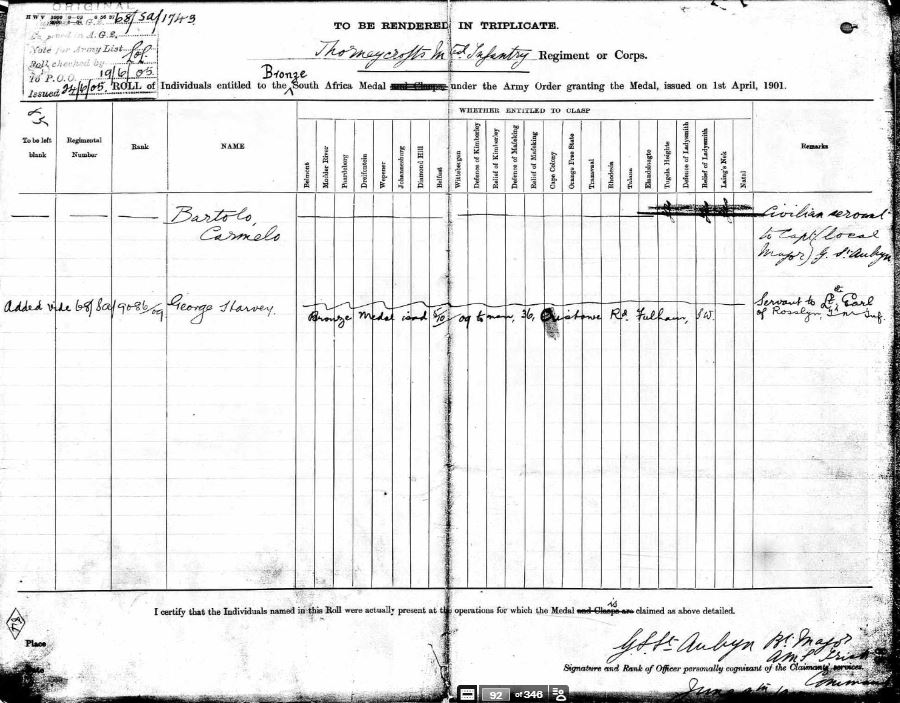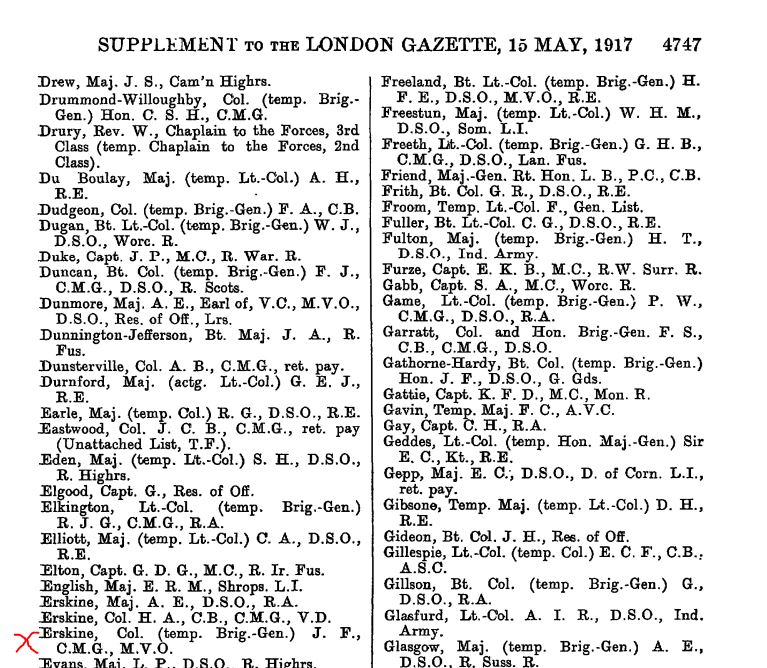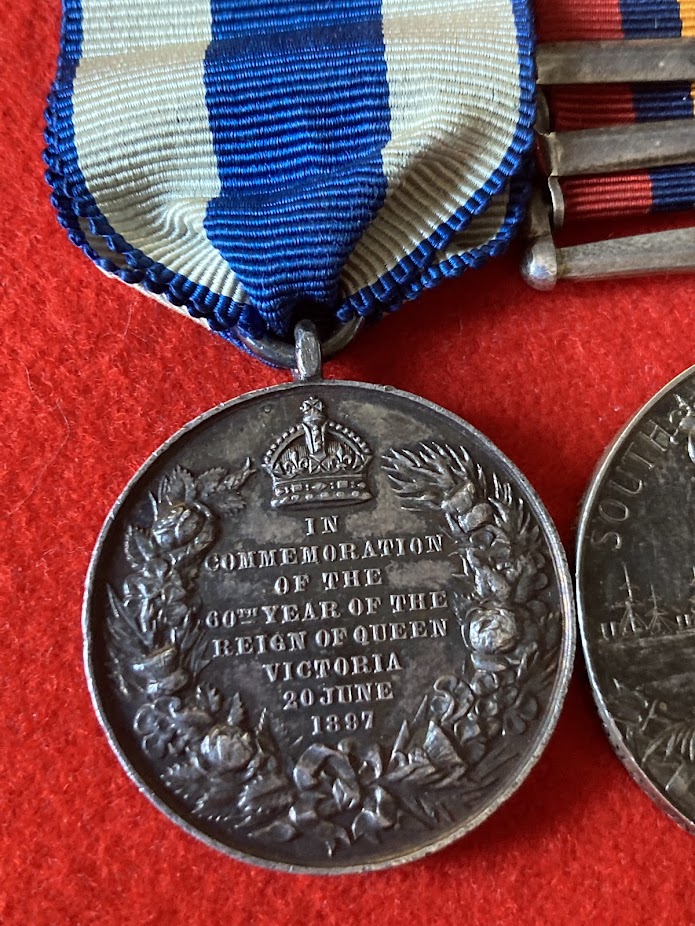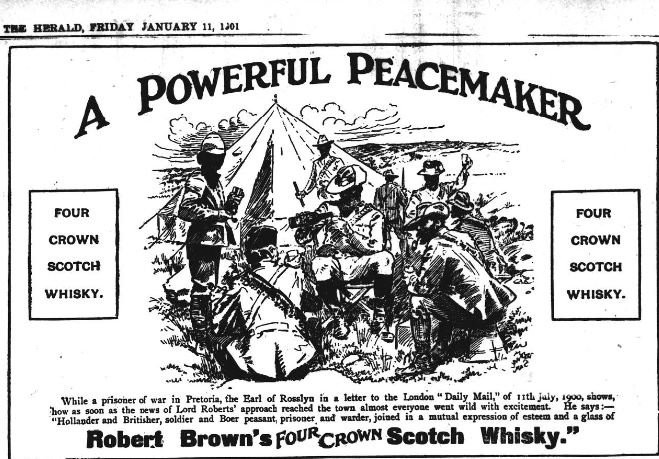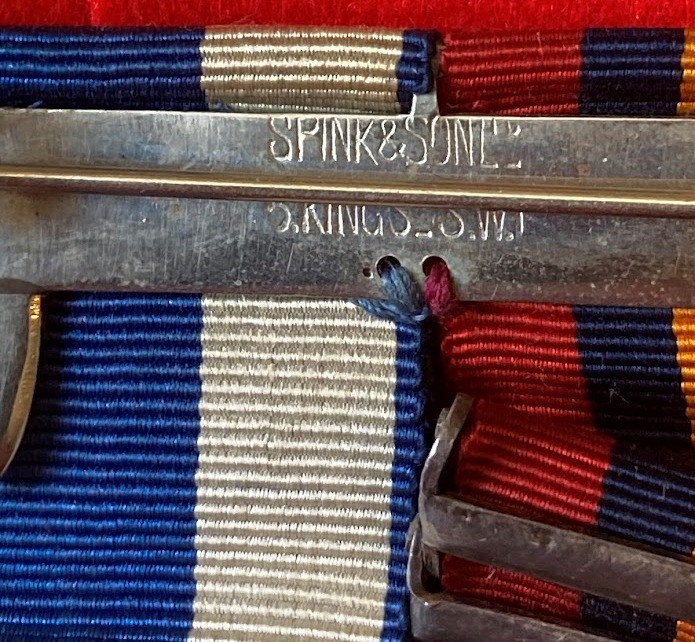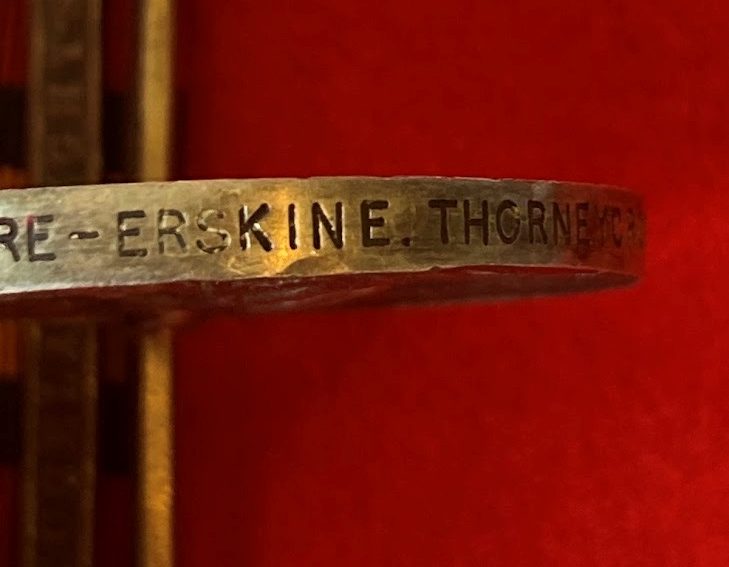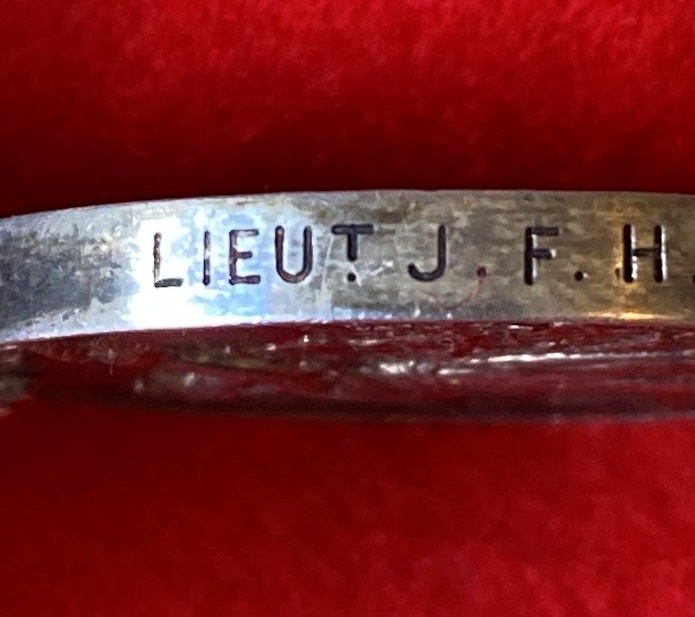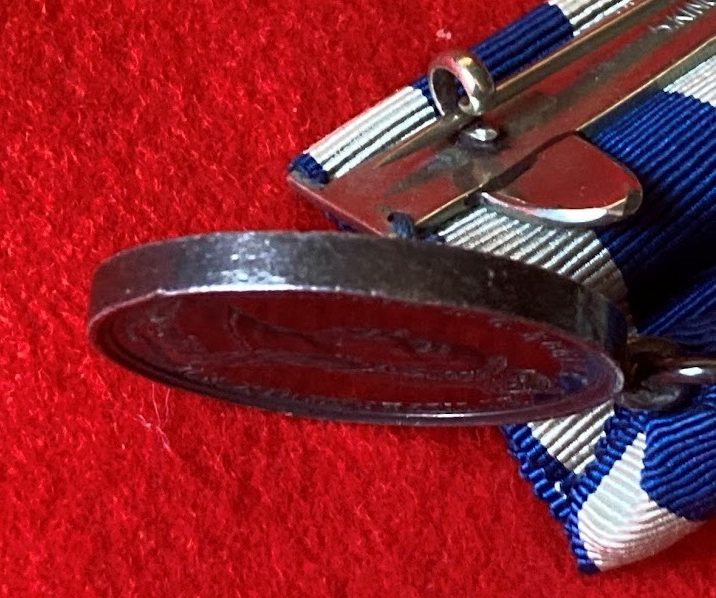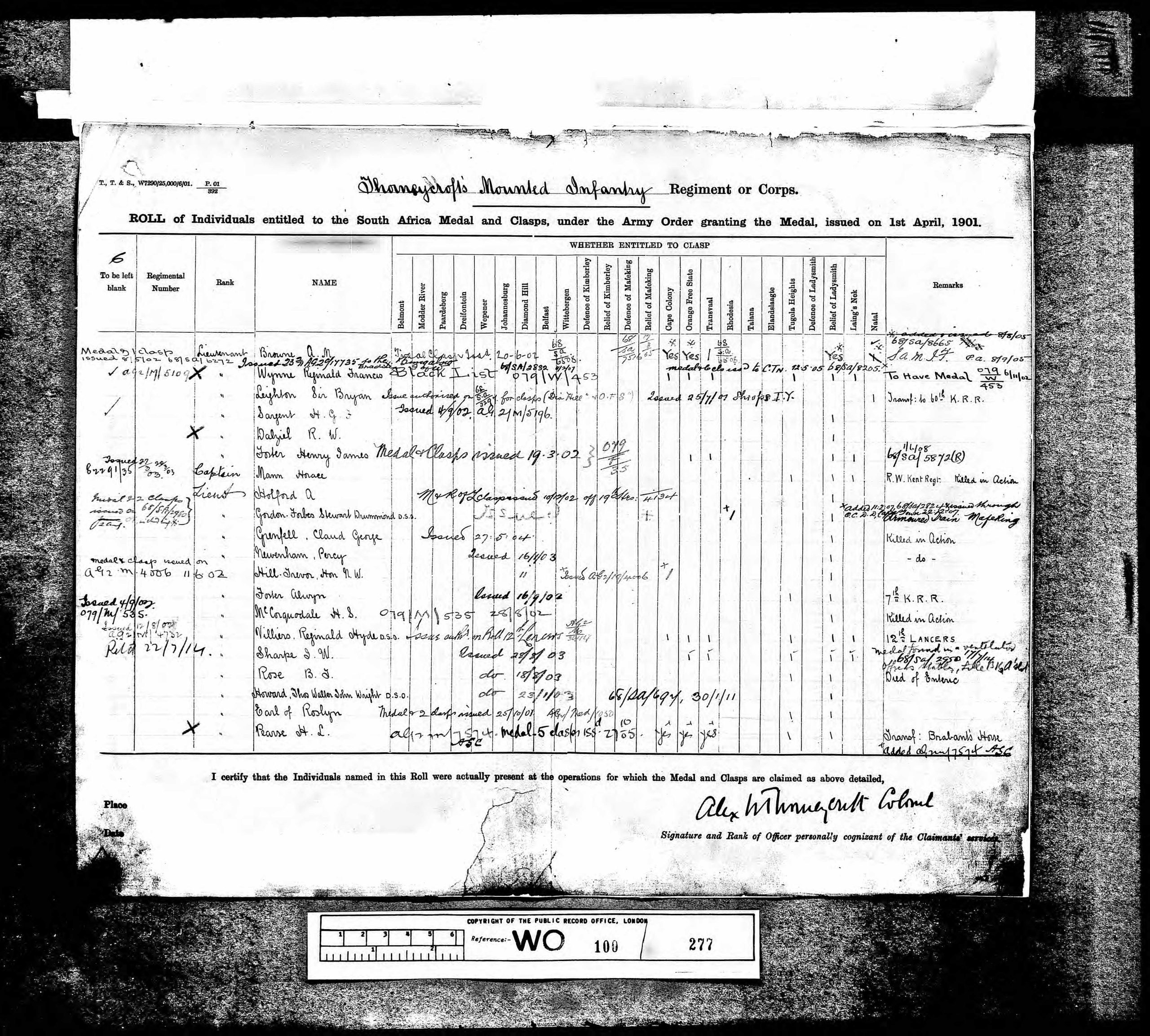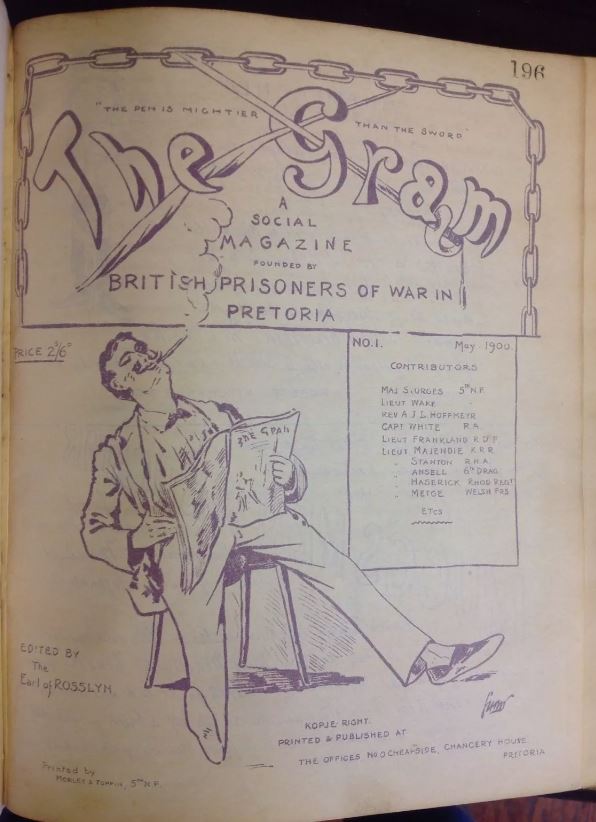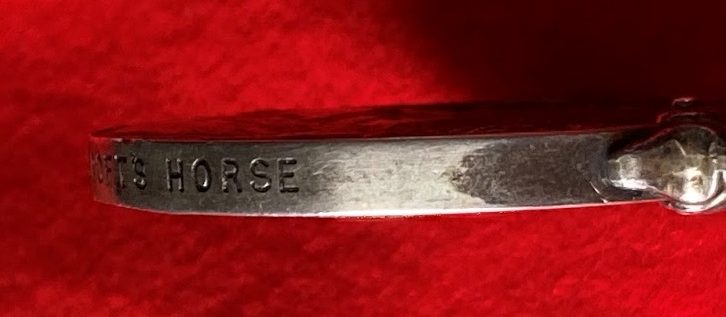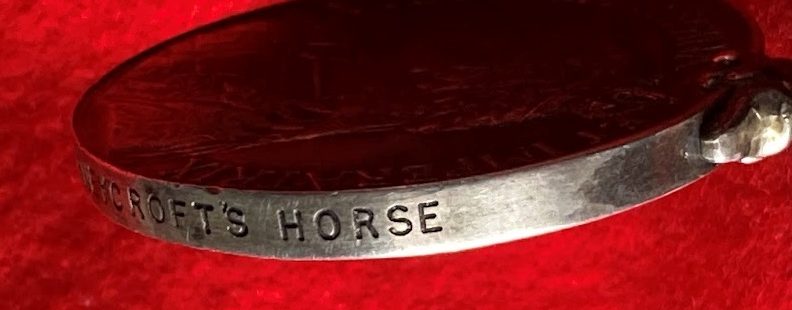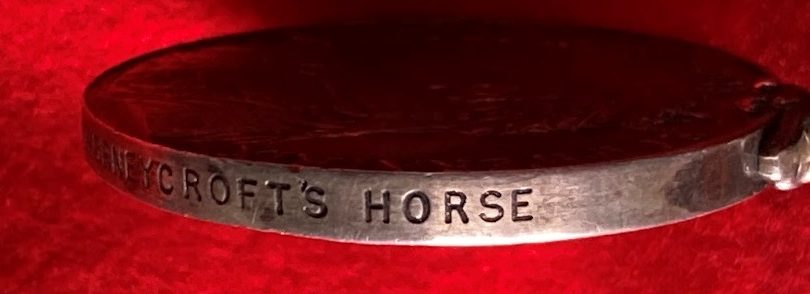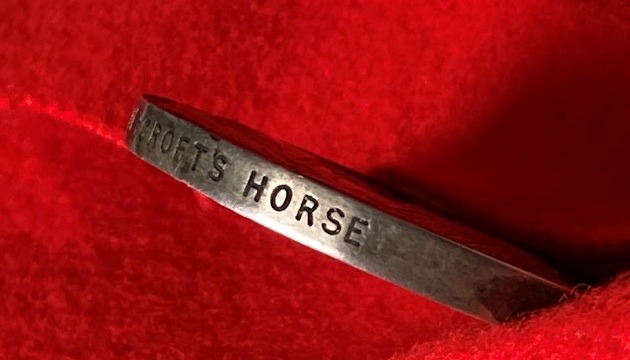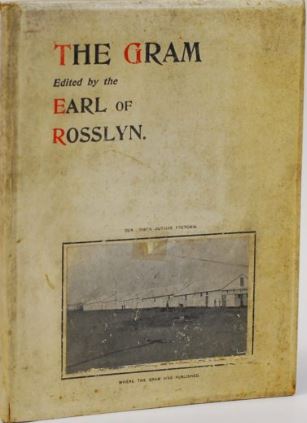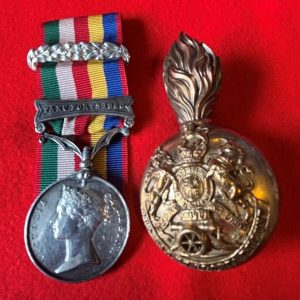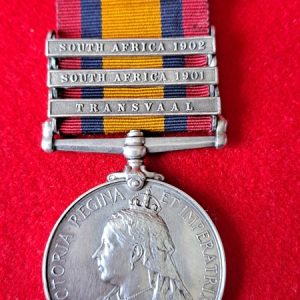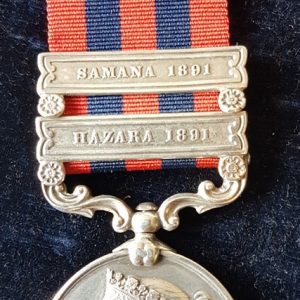Description
The unique Anglo Boer War medal and Queen Victoria Jubilee medal pair to James Francis Harry St. Clair-Erskine, 5th Earl of Roslyn, Thorneycroft’s Horse and scarce War Correspondent’s medal.
Sent out to report the Boer War as War Correspondent for the Daily Mail and The Sphere James Francis Harry St Clair-Erskine, 5th Earl of Rosslyn also served as a Lieutenant in Thorneycroft’s Mounted Infantry for the brief period of 3 weeks during which he was actively involved in the Battle of Tugela Heights and the Relief of Ladysmith. Later, as a War Correspondent he was taken captive twice which gave him the title of his 1900 book Twice Captured.
medals – Queen’s South Africa Medal with Tugela Heights and Relief of Ladysmith clasps to – LIEUT. J.F.H. ST. CLAIRE-ERSKINE. THORNEYCROFT’S HORSE and Queen Victoria’s 60th Jubilee medal.
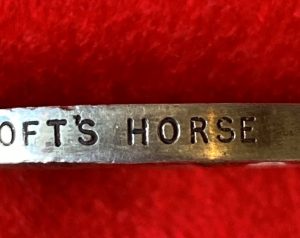
James Francis Harry St Claire-Erskine, 5th Earl of Roslyn
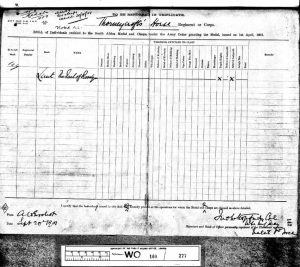
His name is the sole name on the sole medal roll for Thorneycroft’s Horse dated September 1901 as Earl of Roslyn which confirms the Tugela Heights and Relief of Ladysmith clasps. His name, Earl of Rosslyn, also appears on the War Correspondents medal roll though this has been struck through and furthermore the Thorneycroft’s Mounted Infantry roll confirms that this medal with 2 clasps had already been issued 25th October 1901. No other medal roll for Thorneycroft’s Horse has been seen.
Medals for Thorneycroft’s Mounted Infantry are listed on the numerous medals roll thus titled. This is the only medal issued on a roll to THORNEYCROFT’S HORSE.
He wrote in detail of his time in the Cape in his work: Twice Captured – A Record of Adventure During the Boer War. Published by: William Blackwood and Sons, Edinburgh, 1900. A copy of this book accompanies this medal pair. He authored two books, Twice Captured as mentioned above which is a fascinating account of his journey and entry into the Cape. This first part being his involvement in the Absent Minded Beggar Fund. His meetings with Milner, Rudyard Kipling, Lady Randolph and Jack Churchill, Lord Roberts to name but a few of the highest in Military and Civilian Society. Then his active service, of 3 weeks, with Thorneycroft followed by his exploration of the region. He later wrote his autobiography in the late 1920s – My Gamble with Life. This details his early service in the Cavalry through to his wartime service in World War 2.
The introduction to Twice Captured begins – Not only was I present at the battle of Pieters Hill and the subsequent Relief of Ladysmith in a soldier’s capacity, but having crossed Basutoland by a hitherto almost untravelled track, I got through the Boer lines near Thaba Nchu, was taken prisoner at Dewetsdorf, escaped from my Boer guards, and was recaptured at the Reddersburg disaster, into which battle I unwittingly drove, and where I was fired on by both the British and Boer troops! My enforced journey to Pretoria, culminating in nine weeks’ imprisonment, gave me an insight into the manners and methods of the Boers second to none. I also had the opportunity afforded me of being confined in all the three different prisons! Moreover, my last week in Pretoria, when the famous if premature telegram was sent, and my subsequent journey to Bloemfontein during the time De Wet was cutting the lines of communication, form by no means the least interesting items in an eventful six months’ campaign.
Whilst held captive on the second occasion a camp newspaper was founded called The Gram. Rosslyn edited this publication which is rich in tales and stories of camp life. 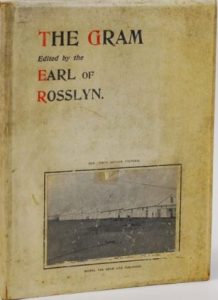
He attracted much criticism in Twice Captured due to his negative description of the Cavalry’s actions at Sanna’s Post. Newspapers of the day carried letters drawing much opprobrium including a response from Lord Roberts himself (see images). He also wrote harshly of Winston Churchill’s time as prisoner of the Boer drawing a direct response from Churchill himself. Rosslyn eventually withdrew the book from the market.
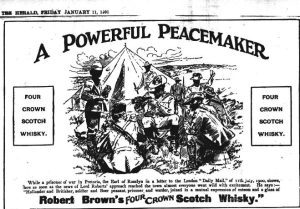 In the Great War 1914/18 he initially held the rank of Major in the King’s Royal Rifle Corps, WO 339/19070 (Major James Francis Henry St Clair-Erskine (5th Earl of Rosslyn). He was not awarded any Great War medals. He notes this in his autobiography My Gamble My Life when describing his wife’s group of 4 medals compared to his solitary QSA (see below).
In the Great War 1914/18 he initially held the rank of Major in the King’s Royal Rifle Corps, WO 339/19070 (Major James Francis Henry St Clair-Erskine (5th Earl of Rosslyn). He was not awarded any Great War medals. He notes this in his autobiography My Gamble My Life when describing his wife’s group of 4 medals compared to his solitary QSA (see below).
As a highly colourful Member of the Aristocracy he was renowned as a thrice married Gambler, Horse Owner, Writer, Actor and Soldier, he was also a Lord Temporal and Justice of the Peace,
Obituary Ballymena Weekly Telegraph Saturday 19th August 1939
DEATH OF THE EARL OF ROSSLYN. – A MAN OF MANY PARTS – LOST £250,000 ON TURF – WAS FRIEND OF EDWARD VII.
The Earl Rosslyn died last week at his London home, aged 70. Society leader, actor, soldier, war correspondent, thrice a husband, friend of a king and a gambler for great stakes these were the characteristics Lord Rosslyn’s extraordinary career. Above all he was a gambler in the grandiose style associated with the Turf and the card rooms of thirty years ago. He squandered on his own estimate £250,000 in betting. He was a close friend of King Edward VII. when Prince of Wales until the friendship was broken following some of the earl’s escapades. Lord and Lady Rosslyn returned to London recently from a trip abroad, during which they travelled over 1,000 miles up the Amazon. Lord Rosslyn, who had a nervous breakdown on the way home, was ordered a complete rest. His breakdown was partly caused by reports that his daughter. Lady Mary Dunn, had had her foot bitten off by a crocodile. She had injured her foot and had been hunting crocodiles and the two incidents were connected. Lord and Lady Rosslyn travelled by a cargo ship and it was not until they reached Lisbon that they received a letter telling them the reports were untrue. Bom on March 16, 1869, he was the fifth earl and after being at Eton and Oxford he succeeded to the title at the age of 21 on the death of his father. The fact that my father was stricken with paralysis when I was only 19 years of age,’ he once said, “must to certain extent account for many of my lapses
“£250 A YEAR AND DEBTS.” The death of his father was one of the turning points in his career. The fourth earl was a man of strict character. Before his father’s death Lord Rosslyn had, to use his own words “an income of £250 a year and his debts.” When the father died he found at the age of 21 that he had £171)00 a year and £50,000 “in the funds.” Writing in a book which he called “My Gamble With Life,” published by Messrs. Cassell, Lord Rosslyn said, “without hardly realising the small fortune I had been left X set to work to spend it. It was a truly liberal bequest to a son who had been living about £250 a year plus his debts and I took to racing soon after my father’s death,” In a few years he had squandered a fortune and he estimated his total turf losses at £250,000. He afterwards admitted that he had been “one of the biggest mugs.” He finally gave up betting in 1926. His most famous horse was Buccaneer which won the Ascot Gold Cup and other races. When he had the Gold Cup valued and found it to be worth only £330 instead of the £l,OOO stated on the race card, he pointed out this fact to the Race Committee and in the following year £2,000 was added to the value of the race.
LOST BET OF £15,000 TO £60,000. He lost his biggest bet of £15,000 to £60,000 on Buccaneer for the Manchester Cup, but he won £15,000 when the horse ran io victory in the Great Ebor at York. At the time he was at home in Fife where his first wife was expecting their first child and he did not wish to be long away he chartered a special train to and from York in order to see the race. Once he brought off a great coup on the tables at Monte Carlo, where after losing £7,000 during a three months’ stay he drew fifty thousand francs from the bank for a last fling before I left for home and sanity.” In a few minutes he recovered all he had lost in the three preceding months. Lord Rosslyn gained the friendship of King Edward VII. —then Prince of Wales —largely through their joint love of the Turf. King Edward proposed the health of the bride and groom at the Earl’s first marriage in 1890. HOW HE FELT KING’S DEATH. Writing in “My Gamble With Life,” he said:— “I think I felt the King’s death more than my father’s,” Going on the stage, but especially “my rotten second marriage,” caused a complete rupture of his friendship with the Prince. “It was only a few months before his death that my sister told me that he intended to forgive me and forget my follies. But his death left me still sorrowing to have pained a great man, a very kind friend, and a marvellous King.” Lord Rosslyn could be numbered as one of the first Society “gate crashers,” though in his case the gate-crashing was not intentional. In 1897 he went to a ball given by the father of the present Lord Derby, at Derby House, London, at which the Prince of Wales (later King Edward) was present. He thought he was among the invited guests, but it was subsequently found that no invitation had been extended to him. Telling his own story, he says: “I shook hands with Lady Derby, when Lord Derby, whom I knew only by sight, came up to me and said: ‘Lord Rosslyn, I believe.’ He then said, T am afraid you are not invited to my house. must ask you to go.’ After expressions of apology he left, and the piquant incident closed a few days later with apologies from both sides when the mistake was explained. The Earl’s domestic life was unhappy until his third marriage. He obtained a divorce from his first wife for desertion under the Scottish law. She was Miss Violet Vyner, of a well-known Lincolnshire family. The Earl’s, second marriage in 1905 was to Miss Anna Robinson, an American actress, who obtained a divorce two years later. His third wife was Miss Vera Mary Bayley. the daughter of a lieutenant in the Lancers.
ON STAGE AS “JAMES ERSKINE.” Lord Rosslyn had many dealings with moneylenders, and after his bankruptcy, filed on his own petition, he was for different periods, totalling seven years, on the stage. He was with a touring company in the provinces for some time, and gained much success in historical plays. He also appeared in the West End with Sir (then Mr.) Gerald du Maurier, and with Miss Irene Vanbrugh. His stage name was James Erskine. The family name of the Rosslyns is St. Clair-Erskine. For a few seasons in the nineties he played cricket for Northamptonshire. He served as an officer in horse regiments in the South African War, and he was at the relief of Ladysmith. He also acted as a war correspondent. After the war he returned to the stage. His financial affairs to some extent recovered, and he interested himself in the coal trade, but he later leased bis coal mines in Scotland. His eldest son. Lord Loughborough, died under tragic circumstances following fall from a window in London in 1929. The heir to the Earldom Lord Rosslyn’s grandson, the present Lord Loughborough, who is 22 years of age.
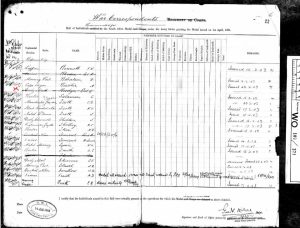
War Correspondents Medal Roll
Born 6 March 1869 – Died 10 August 1939 (aged 70).
Member of the House of Lords, Lord Temporal, in office 6 September 1890 – 10 August 1939
He was the son of Robert Francis St. Clair-Erskine, 4th Earl of Rosslyn and Blanche Adeliza Fitzroy. He married, firstly, Violet Aline Vyner, daughter of Robert Charles de Grey Vyner and Eleanor Margaret Duncombe Shafto, on 19 July 1890. He and Violet Aline Vyner were divorced in 1902. He married, secondly, Anna Robinson, daughter of George Robinson, on 20 March 1905. He and Anna Robinson were divorced in 1907. He married, thirdly, Vera Mary Bayley, daughter of Eric Edward Bayley, on 8 October 1908.1 He died on 10 August 1939 at age 70.
He succeeded as the 5th Earl of Rosslyn on 6 September 1890. He succeeded as the 5th Baron Loughborough on 6 September 1890. He succeeded as the 9th Baronet Erskine, of Alva on 6 September 1890.
He held the office of Deputy Lieutenant (D.L.) of Fife. He was Private Secretary to the Secretary of State of Scotland in 1904. He held the office of Justice of the Peace (J.P.) for Fife.
He was educated at Eton College, Windsor, Berkshire, England then at Magdalen College, Oxford University.
Roslyn had a major gambling problem, he was a notorious gambler, betting £15,000 on Buccaneer to win the Manchester Cup, which lost. He played the roulette tables at Cannes and Monte Carlo, which he wrote about in his autobiography My Gamble With Life. By 1896, he had lost everything and was declared bankrupt, which led to the family silver, gold and silver plate being sold at a three-day auction in Edinburgh. In 1902, he lost £310 while playing poker. In 1903, he was in Court for refusing to pay a $150 draft. In 1908, Rosslyn and Sir Hiram Maxim were in the news for a gambling duel in Monte Carlo to “break the bank”.
medals – Queen’s South Africa Medal with Tugela Heights and Relief of Ladysmith clasps to – LIEUT. J.F.H. ST. CLAIRE-ERSKINE. THORNEYCROFT’S HORSE and Queen Victoria’s 60th Jubilee medal (unnamed, as issued), swing mounted on a SPINK bar. (2) Medal is 100% correct.
Additional notes:
The Great War medal group to Vera Mary Bayley , later Countess of Rosslyn (she married the 5th Earl in 1908) was sold at DNW 2013 with the notes – ‘During the War, I had seventeen Belgian refugees planted on me – it was a pleasure not a duty – but their long sojourn with me made the labour and expense somewhat difficult for us, though my wife received the Medaille de la Reine Elisabeth. Hers was a wonderful career. She joined my sister’s (The Duchess of Sutherland) hospital at the front early in the War, coming home on rare occasions and remained with her till our youngest son, David, was born. It was almost a plaisanterie to find her with a row of medals while I have none (except the South African).’ My Gamble with Life, by the 5th Earl of Rosslyn, refers.
George Harvey, noted on the roll as Servant to Lt The Earl of Rosslyn, was awarded the Bronze Queen’s South Africa medal (W/O 100/27).
Grandson THE HON. PETER GEORGE ALEX ST. CLAIR-ERSKINE, died whilst serving with 111 Sqdn., Royal Air Force 08 September 1939. He is buried at the family chapel, the world famous Rosslyn Chapel.
Rosslyn also edited THE GRAM, A Social Magazine founded by British Prisoners of War in Pretoria, London: Eyre & Spottiswoode, (1900) 1st ed.
Twice Captured – Chapter XVIII fascinating story ref his involvement in uncovering a Boer munitions stash under some graves and Uncle Tom’s Cabin.
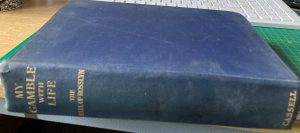
My Gamble My Life by The Earl of Rosslyn
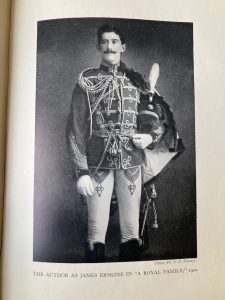
My Gamble My Life by The Earl of Rosslyn
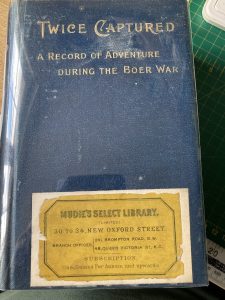
Twice Captured by The Earl of Rosslyn
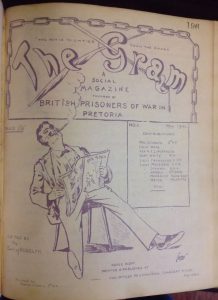
The Gram edited by Lord Rosslyn
Further images of the naming –
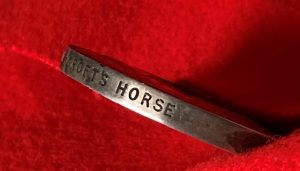
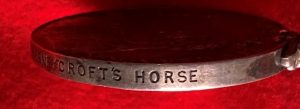
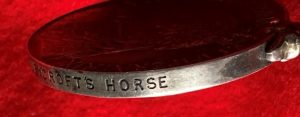

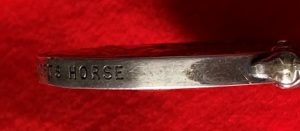
PAYPAL is NOT available for this item. Overseas buyers must contact us to agree shipping prior to order. Email ttandm4h@outlook.com for details or call 07765 595662 to arrange.
Card Payment on Checkout, Bank Transfer (Account name: ttandm4h, Sort Code 30-94-41, Account number 48469068).
Part Exchange considered.

